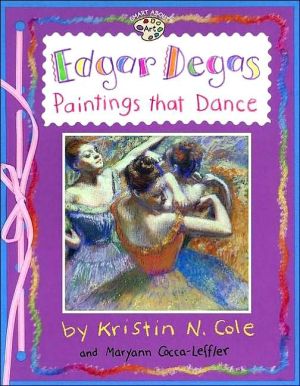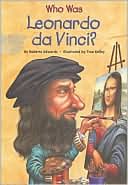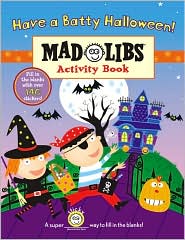Edgar Degas: Paintings That Dance
Edgar Degas is famous for his paintings of ballerinas, and that's what first attracts "Kristin" to his artwork. But as she studies him for her report, she discovers that his art ranged far beyond the ballet and she gradually learns exactly what makes Degas' work so unique.
Search in google:
Edgar Degas is famous for his paintings of ballerinas, and that's what first attracts "Kristin" to his artwork. But as she studies him for her report, she discovers that his art ranged far beyond the ballet and she gradually learns exactly what makes Degas' work so unique.Publishers WeeklyWith a clear, accessible format, the Smart About Art series kicks off with Edgar Degas: Paintings that Dance by Maryann Cocca-Leffler; Claude Monet: Sunshine and Waterlilies by True Kelley; and Vincent van Gogh: Sunflowers and Swirly Stars by Joan Holub. Each presents factual information about each artist in the style of a school report, interjecting the narrative with the voice of a child writer. In Degas, for instance, "author" Kristin pastes in a photograph of herself in fourth position (aping one of Degas's sketches of a ballet dancer); in Monet, the narrator compares two paintings of the same scene, one by Renoir and one by Monet. Full-color photos and reproductions of the paintings illustrate the text. Copyright 2001 Cahners Business Information.
\ Publishers WeeklyWith a clear, accessible format, the Smart About Art series kicks off with Edgar Degas: Paintings that Dance by Maryann Cocca-Leffler; Claude Monet: Sunshine and Waterlilies by True Kelley; and Vincent van Gogh: Sunflowers and Swirly Stars by Joan Holub. Each presents factual information about each artist in the style of a school report, interjecting the narrative with the voice of a child writer. In Degas, for instance, "author" Kristin pastes in a photograph of herself in fourth position (aping one of Degas's sketches of a ballet dancer); in Monet, the narrator compares two paintings of the same scene, one by Renoir and one by Monet. Full-color photos and reproductions of the paintings illustrate the text. Copyright 2001 Cahners Business Information.\ \ \ \ \ Children's LiteratureA brief biography of Degas and a discussion of his works are cleverly disguised as a school report by Kristin Cole, a little ballet student and admirer of the artist. Originally attracted by his interest in ballet girls, Kristin researches his life and illustrates her paper with perky cartoons as well as many reproductions of Degas' paintings and his Little Dancer sculpture. The facts are set out in boxes amid the brightly colored illustrations in a lively and eye-catching format. Kristin traces Degas' life from his birth into a wealthy family in Paris to his determination to study art, his choice of subjects (favorites being horseracing and ballet), the influence of Japanese art and photography on his work to his later pastels and to his death at age 83. Simple language, accurate research and an appealing presentation make this an effective introduction to a famous artist. It is part of the "Smart about Art" series. 2001, Grosset & Dunlap/Penguin Putnam, $14.89 and $5.99. Ages 8 to 12. Reviewer:Patricia Dole\ \ \ School Library JournalGr 1-3-The conceit behind these biographies is that they were written by elementary-grade students as reports on the painters. Each book opens with a letter from their teacher, "Ms. Brandt," outlining some questions the student might want to think about when preparing the assignment: why did you pick this artist; if you could ask him or her three questions what would they be; and did you learn anything that surprised you? Unfortunately, the end results are cluttered pages and possibly confusing content. While each book includes facts about the subject's life (birth date and place, childhood, work, etc.), it also incorporates little bits of information about the child who is writing the report. For example, Kristin, the "author" of Degas, includes her own self-portrait next to the artist's. The material presented on each subject is strictly biographical; there is no discussion of the artists' technique or place in art history. Colorful pages and lettering highlight the many reproductions, photographs, childlike drawings, and snippets of text. The "Getting to Know the World's Great Artists" series (Children's) presents solid factual information along with reproductions. However, for an engaging introduction to an artist by a fictional character, steer readers to Christina Bj rk's Linnea in Monet's Garden (R & S, 1987) or Neil Waldman's appealing The Starry Night (Boyds Mills, 2001).-Susan Lissim, Dwight School, New York City Copyright 2001 Cahners Business Information.\ \








